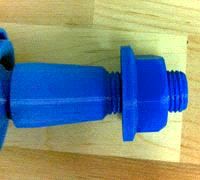Inkjet & Digital Printing
SPRINGING INTO ACTION

Wednesday 02. April 2014 - Suspension Parts Fabricator Shaves Months Off Manufacturing Timeline
When drivers invest in new tires, it’s critical their suspension systems are up to the task of carrying two tons of steel atop the new rubber. Beginning with the advent of front-wheel drive cars in the 1970s, both sets of wheels required precise alignment to prevent tire wear and handling problems. Mechanics soon realized they needed a way to adjust camber/caster and rear toe settings on vehicles that were being produced with no factory means provided.
“Every new vehicle produced since the 1970s has required custom-fabricated alignment tools and replacement parts,” said Miller. “Since then, Northstar has developed a complete line of adjustment products designed to solve alignment problems. We sell to the big stores like Pep Boys and Firestone, but also to small mechanic shops – basically, anybody who sells tires also needs our products to ensure a good fit and balanced alignment.”
Miller and his team design and build between five and ten new products each year, as most new vehicle models require camber/caster adjustment within three years. This complex, detail-oriented work usually takes 4-6 months, as Northstar must wait to receive the corresponding vehicle part before designing an adjustment piece (such as a shim), then wait several weeks for a third-party machine shop to create a prototype.
“With outsourced prototyping, we didn’t have the luxury of making the designs look perfect,” Miller said. “Even the smallest design tweak required several turn-around days, so we focused our efforts on making the pieces work instead of making them look cool.”
Choosing Dimension
Matt Havekost of Advanced Technology Systems, a longtime authorized reseller for Stratasys, had been calling on Shawn because he knew a Dimension 3D Printer would be a productive tool for Northstar. But the sales process stalled because of the perception that Northstar didn’t produce enough new products in a year to justify the purchase. It wasn’t until Shawn understood that the durable 3D printing medium would allow him to produce functional manufacturing tools – such as “go/no-go” gauges and check fixtures – that the sales process moved forward.
“Shawn and I talked at length about some issues they were having with manufacturing, particularly with tight tolerances for custom wrenches and other adjustment tools,” Havekost said. “I told him that with a 3D printer, he could test designs before forging the tools and shave off millimeters if needed to ensure it stayed within the variance guidelines.”
For Northstar, a Dimension 3D Printer granted Shawn and the other product developers the best of both worlds – concept modeling and tool manufacturing in one package. For example, when parts from an overseas factory weren’t aligning properly during assembly, Northstar used the Dimension 3D Printer to fabricate a “check fixture” – a sizing tool that measured the accuracy of manufactured parts and ensured each one would be functional. Northstar now sends the printed check fixtures overseas for their manufacturer’s use, in addition to using them in their receiving department before putting the parts into inventory.
“The durability of the Dimension 3D printing materials was crucial for allowing Northstar to use the printer for both tool manufacturing and prototyping,” Havekost said. “You simply can’t do both with other pieces of equipment on the market.”
After purchasing a Dimension SST 1200es 3D Printer, Miller and his team found parts that used to take three or four months to design and build now took a few days. Northstar engineers can now bring a vehicle part (or the entire vehicle) into the garage as they are brainstorming ideas, then start printing prototypes immediately. Northstar can also get computer aided design (CAD) drawings from vehicle manufacturers to determine precise measurements, then input those measurements to the Dimension 3D Printer and make a prototype for same-day testing.
“One of the biggest advantages of having the Dimension 3D Printer is how much it helps our overseas machining work,” Miller said. “It’s often difficult to translate minute design details to plant managers over in Asia, but when we can send them a physical prototype it is very easy for them to copy it with accuracy.”
Detailed Prototypes, Manufacturing Tools Ensure Proper Fit
Miller says the Dimension 3D Printer is great for producing highly detailed prototypes, right down to the critically important threaded bolts and moving parts. Precise measurement is paramount when constructing alignment equipment, as a few millimeters’ difference can render a tool worthless and even dangerous to use.
“One of the harder things to model in a prototype is moving parts – threaded bolts, nuts, screws and hinges in particular,” Miller said. “The Dimension 3D Printer not only makes it feasible, but does the work effortlessly and accurately the first time.”
Miller also uses the Dimension 3D Printer to produce sales materials for trade shows, customer training sessions and technical demonstrations. Instead of showing an entire vehicle or alignment part, Northstar can show fully functioning scale models that will help distributors and sales people market the product.
“The Dimension 3D Printer allows us to produce detailed training aids, – including cut- away models – so our sales representatives can let distributors or resellers touch, feel and interact with our products before buying them,” Miller said. “The Dimension 3D Printer is versatile and dependable – it saves us money and time by allowing us to design more products more efficiently than ever before.”
